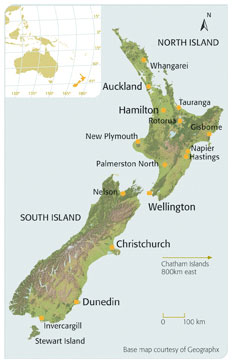New Zealand backgrounder
 |
Natural environment
New Zealand is an island country in the south-west Pacific, comparable in size (268,680 sq km) to the United Kingdom and the Philippines. New Zealand comprises the North Island and South Island, and a host of smaller islands. Extensive areas are set aside as national parks. Generally, New Zealand has a temperate climate, although the far north may experience subtropical weather during summer, and the inland alpine areas of the South Island can get very cold in winter. Although average annual temperatures are not extreme, from 16°C in the north to 10°C in the south, be prepared for the unexpected when engaged in outdoor activities. On any day, the weather can change suddenly with a cold front or rain setting in. The North Island is mainly rolling hill country, much of which is farmed. The South Island is divided by the Southern Alps, which run most of its length and rise to over 3,000m. Nowhere in New Zealand is more than 130km from the sea.
Government
The capital is Wellington, and the largest city and main port is Auckland. New Zealand is a parliamentary democracy and a member of the Commonwealth.
Language and religion
English is the everyday language of New Zealand. English, Māori, and New Zealand Sign Language are recognised as official languages. One-third of New Zealanders are not affiliated with any religion. Of those who are, the largest denominations are Anglican, Catholic, and Presbyterian.
Population
New Zealand has a diverse multicultural population of over 4 million people, making it one of the world's least crowded countries. New Zealand's indigenous Māori, a Polynesian people, make up around 15 percent of the population.
History
New Zealand as a nation state began in 1840. In that year the country became a British colony when more than 500 Māori chiefs and representatives of Queen Victoria signed the Treaty of Waitangi. The treaty is the country's founding document. The Māori name for New Zealand is Aotearoa ('land of the long white cloud'). The name New Zealand was given after the Dutch explorer Abel Tasman made the first recorded European visit in 1642.
Economy
While New Zealand has about 0.1 percent of the world's population, its economy produces about 0.3 percent of the world's material output. Compared with the rest of the world, it is one of the richer economies. New Zealanders are generally well educated, healthy, and have a comfortable standard of living. In 2008, the four largest categories of goods exported made up 44 percent of New Zealand's total exports by volume. These were dairy products; meat and meat products; wood and paper products; and metal products, machinery, and equipment.
 0
0 






